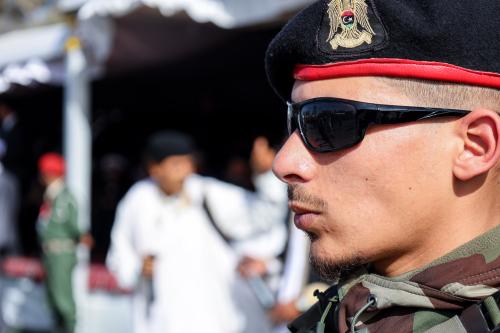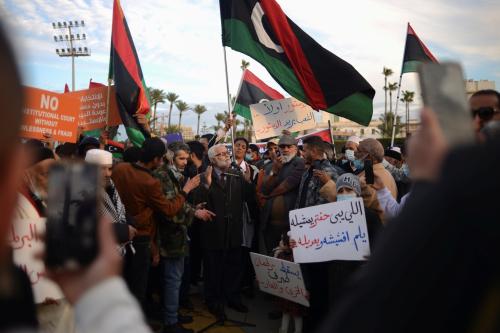This piece is part of a series titled “Nonstate armed actors and illicit economies in 2024” from Brookings’s Initiative on Nonstate Armed Actors.
There have been few shifts in the landscape of Libya’s numerous hybrid armed groups in the past year. In the aftermath of the devastation wreaked by Storm Daniel, which in September 2023 took the lives of more than 5,000 with over 8,000 still missing, mostly in Derna, there was a glimmer of hope, since extinguished, that Libya’s armed factions would come together for the sake of the country. Although the October 2020 cease-fire continues to hold broadly, and its authors — the members of the Joint Military Commission — continue to meet, some of the agreement’s demands have yet to be fulfilled, notably the withdrawal of foreign forces and mercenaries. A large-scale return to violence, such as witnessed between 2019-2020, is probably not in the cards, due in part to an assumed tacit arrangement between Russia and Turkey.
The Haftars and Libya’s east
As we survey the Libyan armed group terrain from east to west, there has been increasing focus on eastern Libya and the future of the Libyan Arab Armed Forces (LAAF) — an amalgamation of militias sometimes also referred to as the Libyan National Army — as the group’s founder and current leader, the octogenarian General Khalifa Haftar, moves inexorably toward the exit. Haftar’s sons are jockeying for positions to succeed him, while their father continues to be courted by an astonishing array of senior international civilian, military, and intelligence officials. In the succession sweepstakes, the consensus view is that Haftar’s military heir apparent, Saddam Haftar, who was recently promoted to the rank of two-star general along with his brother Khaled, will assume control of the LAAF. According to the United Nations Panel of Experts Report published in September 2023, which covered the period from April 2022 to July 2023: “The effective control exercised by the Haftars, in particular Haftar’s youngest son, brigadier Saddam Haftar, over key LAAF units, financial institutions and political bodies reached unprecedented levels during the reporting period. The Haftar family took control of most social and economic life in eastern Libya.” There are also indications that Saddam is increasingly involved in human smuggling activities.
While Haftar père’s departure may cause some perturbations in eastern Libya, it is equally the case that the passing of the torch to the next generation could be relatively smooth. The Haftars have been efficient in suppressing and even preempting dissent, as witnessed most recently in the apparent violent dispatch of Mahdi Al-Barghathi, a one-time LAAF senior officer who, over Haftar’s objections, served as the defense minister in the U.N.-recognized government in Tripoli from 2016-2018. After an absence of some years, Barghathi returned to his hometown of Benghazi in October 2023 and, according to the U.N. mission, appears to have perished along with many other partisans after, as reported in the press, being captured by the LAAF’s Tariq Bin Zayid Brigade (controlled by Saddam Haftar). Moreover, Egypt has a vested interest in ensuring LAAF continuity and control in eastern Libya, an area which it views as its strategic depth.
Militias and sporadic violence in Libya’s west
By contrast, the hybrid armed group environment in western Libya remains highly fragmented. In Tripoli, three major groups dominate: the Deterrence Apparatus for Combating Organized Crime and Terrorism (DACOT, also known as the Special Deterrence Force or Rada), the so-called Stability Support Authority (SSA), and the 444 Brigade. In an all-too-familiar scene in the country’s capital over the last decade, some 55 people were killed and nearly 150 wounded in clashes between DACOT and the 444 Brigade in August of last year, following DACOT’s detention of 444’s powerful commander, Mahmoud Hamza. The conflict was settled relatively quickly, Hamza was released, and the groups went about business as usual. Such turf wars were also unfortunately common during my tenure with the United Nations in Libya between 2018-2022.
Those who have paid the ultimate price in terms of lives and damage to infrastructure are Tripoli’s civilian residents. The Tripoli armed groups continue to distinguish themselves through their predation on what remains of the country’s institutions. Through ill-considered presidential decrees, they have acquired arrest, surveillance, and detention authorities which they routinely employ to coerce and imprison their compatriots and prevent accountability.
Elsewhere in western Libya, the armed group portrait remains highly varied and dependent on local conditions. In many cases, these groups draw salaries from the (non-)state while also extracting rent through any number of illicit activities, including the migrant smuggling business, with all of its attendant horrors.
Civil society and accountability under further threat
Of special concern throughout Libya is the crackdown on freedoms by elements of the LAAF and western hybrid armed groups. The U.N. Fact-Finding Mission on Libya, in its March 2023 report, sounded the tocsin over “[t]he rapid, deep and ongoing absorption of armed groups and their leadership into State-affiliated structures and institutions, including the Libyan Arab Armed Forces, and the spread of Salafist-leaning conservative ideologies … Persons were detained for … criticism of the State and affiliated actors, and expression of divergent political, religious and social views and norms, including their opposition to patriarchy and sexism. Moreover, in the view of the Mission, the practice of conservative Salafist-leaning ideologies compounded the shrinking of civic space.” This regression harkens back to the days of Muammar Gaddafi when the regime exercised almost complete control over the population to the extent that there was no freedom of association and the practice of informing on others had become deeply entrenched in the society.
In this otherwise bleak outlook, one can take some solace from the fact that Libya, since the signing of the U.N.-brokered ceasefire in October 2020, has not witnessed the resumption of the type of large-scale violence that occurred in the country’s second civil war between April 2019 and June 2020 following Haftar’s attack on the U.N.-recognized government in Tripoli. Much credit goes to the Libyan parties to the cease-fire and the U.N. mission for tending to the agreement. But the fragile peace has also been preserved through understandings reached between Russia and Turkey, who in mid-2020 achieved a modus vivendi that allowed for LAAF troops to withdraw to the center of the country and Wagner mercenaries to pull out unharmed from areas in western Libya they had occupied in support of Haftar’s offensive. In exchange for keeping the peace, both countries have been able to use their Libyan proxies to deepen and extend their footprints through privileged access to Libyan bases and the maintenance of official forces and mercenaries.
The Turks have been more transparent about their arrangements with the Libyan authorities; they have returned to a set of military and maritime agreements signed with the previous U.N.-recognized government in the fall of 2019. The Turkish parliament recently approved a memorandum of cooperation that would extend the Turkish presence in western Libya for another two years. During a mid-December 2023 press conference, Turkish Minister of National Defense Yaşar Güler stated that Ankara had trained 15,000 Libyan military personnel since 2020. Güler neither revealed the details of the training nor indicated what if any vetting had been conducted. The Turks have been most closely associated with the 444 Brigade, the Tripoli militia involved in last summer’s violence in the capital. Ankara also maintains a permanent presence in western Libya at al-Watiya airbase near Zintan and the naval base in Misrata.
For their part, the Russians have stepped up engagement with the LAAF, having dispatched Deputy Defense Minister Yunus-bek Yevkurov to eastern Libya several times since August 2023. Haftar was accorded head of state treatment during a September 2023 visit to Moscow where he met with Russian President Vladimir Putin. There is much speculation but few details on Russia’s goals. Following Wagner leader Yevgeny Prigozhin’s sudden demise in August 2023, they could be as limited as rebranding the Libya-based former Wagner mercenaries under more formal Russian Ministry of Defense control to far more expansive ambitions, such as seeking official basing arrangements at the eastern ports of Tobruk or Ras Lanuf. Such deals would allow Moscow to augment its naval presence in the Mediterranean and further threaten Europe’s security.
Thus, amid the tension among the major Libyan parties and despite the country’s occasional violent eruptions, a degree of harmony has ironically been reached between Russia and Turkey, the two major external parties to Libya’s tragedy. Such external concord suggests that in the short term, little will change on the ground, including the disposition of the country’s hybrid armed groups and the continued absence of the state’s monopoly over the use of force.
That the status quo conveniently leaves the predatory ruling class and its associated armed groups in place does not bode well for cultivating a few green shoots of democracy in Libya, especially given the frailty of the public sphere, the absence of accountable institutions, the splintering of personal freedoms, and the suffocation of civil society. The United States can help address this stasis by pursuing the soft power tools provided in the Global Fragility Act’s Libya program, including its important focus on the marginalized south, and by employing Global Magnitsky Sanctions against those who abuse human rights and are implicated in corruption. Recognizing that full-scale Disarmament, Demobilization, and Reintegration (DDR) awaits a comprehensive political settlement, the United States should nevertheless continue to support the modest pre-DDR measures outlined by the United Nations and the Joint Military Commission, including protection of the vital principle of civilian control over the military.






Commentary
Déjà vu: The trajectory of Libyan armed groups in 2024
January 16, 2024